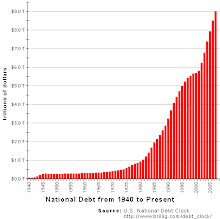Tuesday, February 5, 2008
Labor - the human economic resources
Economic resources are the things people use to attempt to satisfy their needs and wants. They can be divided into three categories: labor, capital, and natural resources.
Labor – the human economic resources
Labor is human effort, both physical and mental. People use their time and effort to produce things that are useful to themselves or others. Examples of labor are teachers, bankers, construction workers, steelworkers, plumbers, entrepreneurs, and managers.
Economists use various terms to describe different types of labor. A white-collar workertypically performs work that does not involve manual labor, is paid an annual salary instead of hourly wages, and is expected to dress with some formality. Examples of white-collar workers are business executives, stockbrokers, insurance salespeople, bankers, and lawyers. The origin of the expression is that men in these professions traditionally wear a white dress shirt, suit, and tie to work. White-collar workers are often associated with the service sector, which is the area of the economy that does not result in the production of a tangible commodity. A tangible commodity is a product that can be touched or held, such as an apple, a sweater, or a house.
A blue-collar worker typically performs work that involves manual labor, is paid hourly wages, and dresses in clothes that may become heavily soiled. Examples of blue-collar workers are automobile mechanics, garbage collectors, and construction workers. The origin of the expression is that men in these professions often wear a uniform with a blue shirt. Blue-collared workers are often associated with the manufacturing sector, which is the area of the economy that produces tangible commodities.
The Rust Belt is the heavily industrialized area of the upper Midwestern U.S. that contains older factories, many of which are closed. Manufacturing jobs in industries such as automobiles, steel, and coal mining used to be a significant source of employment in Michigan, Indiana, Ohio and Pennsylvania. Over the last few decades, Americans have increasingly preferred to buy manufactured products from cheaper foreign producers.
It is normal for there to be changes in the types of industries that are the most successful in a particular economy. Silicon Valley is a region southeast of San Francisco, California, which is known for its computer and other high-technology industries. These American industries flourished in the 1990s, but have faced increasing foreign competition in recent years.
There is a relationship between education, skills, training, and productivity. Productivity is the amount of output that can be produced in an hour of a worker’s time. Increases in education, skills, and training are usually associated with increases in productivity. As people become more productive, businesses are usually willing to pay them more. To illustrate this concept, consider two salespeople. If one person sells $50,000 worth of a company’s products per year while another person generates $1 million of sales per year, who is more deserving of higher pay? Salespeople are usually paid a commission, which means they are paid based on the value of their sales. Consequently, companies usually pay salespeople more when they generate more sales.
This relationship between education and productivity also explains why most students attend college. As people become better educated, they tend to become more productive. More productive people tend to earn higher incomes. Consequently the most frequently cited reason for attending college is to enable people to obtain a better, higher-paying job than would occur in the absence of the education.
Education, skills, and training are sometimes referred to as human capital.
Labor – the human economic resources
Labor is human effort, both physical and mental. People use their time and effort to produce things that are useful to themselves or others. Examples of labor are teachers, bankers, construction workers, steelworkers, plumbers, entrepreneurs, and managers.
Economists use various terms to describe different types of labor. A white-collar workertypically performs work that does not involve manual labor, is paid an annual salary instead of hourly wages, and is expected to dress with some formality. Examples of white-collar workers are business executives, stockbrokers, insurance salespeople, bankers, and lawyers. The origin of the expression is that men in these professions traditionally wear a white dress shirt, suit, and tie to work. White-collar workers are often associated with the service sector, which is the area of the economy that does not result in the production of a tangible commodity. A tangible commodity is a product that can be touched or held, such as an apple, a sweater, or a house.
A blue-collar worker typically performs work that involves manual labor, is paid hourly wages, and dresses in clothes that may become heavily soiled. Examples of blue-collar workers are automobile mechanics, garbage collectors, and construction workers. The origin of the expression is that men in these professions often wear a uniform with a blue shirt. Blue-collared workers are often associated with the manufacturing sector, which is the area of the economy that produces tangible commodities.
The Rust Belt is the heavily industrialized area of the upper Midwestern U.S. that contains older factories, many of which are closed. Manufacturing jobs in industries such as automobiles, steel, and coal mining used to be a significant source of employment in Michigan, Indiana, Ohio and Pennsylvania. Over the last few decades, Americans have increasingly preferred to buy manufactured products from cheaper foreign producers.
It is normal for there to be changes in the types of industries that are the most successful in a particular economy. Silicon Valley is a region southeast of San Francisco, California, which is known for its computer and other high-technology industries. These American industries flourished in the 1990s, but have faced increasing foreign competition in recent years.
There is a relationship between education, skills, training, and productivity. Productivity is the amount of output that can be produced in an hour of a worker’s time. Increases in education, skills, and training are usually associated with increases in productivity. As people become more productive, businesses are usually willing to pay them more. To illustrate this concept, consider two salespeople. If one person sells $50,000 worth of a company’s products per year while another person generates $1 million of sales per year, who is more deserving of higher pay? Salespeople are usually paid a commission, which means they are paid based on the value of their sales. Consequently, companies usually pay salespeople more when they generate more sales.
This relationship between education and productivity also explains why most students attend college. As people become better educated, they tend to become more productive. More productive people tend to earn higher incomes. Consequently the most frequently cited reason for attending college is to enable people to obtain a better, higher-paying job than would occur in the absence of the education.
Education, skills, and training are sometimes referred to as human capital.
Subscribe to:
Post Comments (Atom)






Very few jobs today involve manual labor.
ReplyDelete